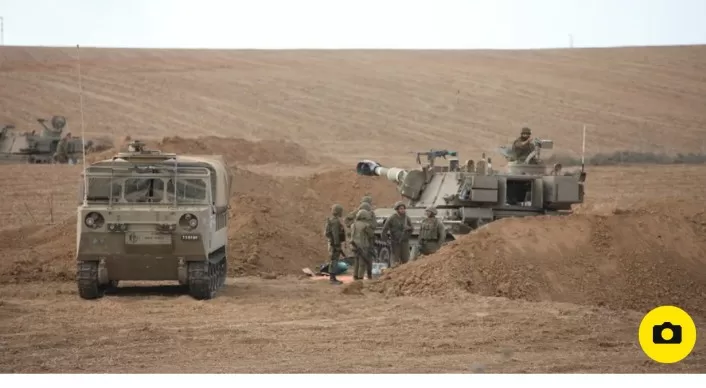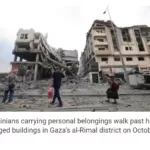Situated adjacent to the besieged Gaza Strip, Road 232 serves as a stark reminder of the ongoing conflict that has engulfed the region. Surrounded by vast agricultural terrain in every direction, the high-rise buildings of Gaza loom on the horizon, a mere 3 miles (5 km) away. Road 232 now marks the de facto boundary between Israeli territory and the domain controlled by Hamas, the militant Islamist organization.
Hamas launched a devastating, multi-pronged offensive, comprising sea, land, and air strikes, targeting 20 neighboring Israeli kibbutzim and towns over the weekend. This ruthless assault led to the loss of over 1,000 lives, with dozens of individuals abducted as potential bargaining chips. In response, Israeli airstrikes have claimed over 900 lives in Gaza, making this the fifth round of conflict since Hamas assumed control of the region in 2007.
However, it is not merely a new border; it is a frontline. The Israel Defence Forces (IDF) initially declared the perimeter with Gaza secure early on Tuesday, but this assurance was short-lived. The resounding echoes of airstrikes, artillery fire, and automatic gunshots reverberate across the desolate fields. Israeli tanks roll down the highway, casting up clouds of soil and dust. Military helicopters hover ominously overhead, while vigilant soldiers at checkpoints scrutinize distant movements. Thick plumes of dark smoke billow above Gaza, casting a somber pall.
Kibbutz Re’im, situated off Road 232, was the site of a horrific massacre. Over 260 individuals attending an all-night rave were ruthlessly murdered at daybreak on Saturday. Survivors recount harrowing tales of playing dead amidst the lifeless bodies of friends, witnessing heinous acts, and enduring violence before their lives were brutally ended. The site now bears grim testimony to these atrocities, as Israeli forces have removed the bodies of the victims, while the perpetrators of this heinous act remain at large.
Along the roadside lie the remains of five individuals, stripped down to their underwear after being examined for explosives. They are surrounded by piles of clothing and military equipment adorned with the insignias of Hamas and Palestinian Islamic Jihad. The road is strewn with damaged vehicles displaying both Israeli and Palestinian license plates.
The town of Sderot, located in the northeast corner of Gaza, has endured its share of hardships. Residents like Katry Kamenetski found themselves in a state of constant fear, as they hid in their apartments during the battle between Israeli forces and militants who had taken over the local police station. Despite her reservations about Sderot, Katry expressed relief at being able to venture outdoors on Tuesday, even as air raid sirens compelled periodic retreats to public bomb shelters.
Katry described the confusion and contradictory messages received during the crisis. She recounted, “Sometimes, the municipality via WhatsApp or social media would declare that it was safe to go outside, despite the ongoing situation. It was only on Monday that my boss asked whether I’d be returning to the office.”
As she spoke, the sound of bulldozers demolishing the police station across the road was audible. The IDF had regained control of the facility on Sunday after a fierce battle, resulting in the death of ten militants. This operation, termed a “pressure cooker” operation by Israel’s armed forces, involves a gradual escalation of firepower on a building housing armed Palestinians, ultimately forcing them to surrender or leading to the structure’s collapse.
Evidence of intense fighting was visible on the main streets of Sderot, with a playground on one side and a library on the other, interspersed with burnt-out vehicles riddled with bullets. Missile strikes in the vicinity and the constant blare of the air defense system served as a reminder of the ongoing turmoil.
The Home Front’s directive to prepare safe shelters and stockpile supplies for 72 hours indicates an impending ground offensive into Gaza, a move likely to exact a heavy toll on both Palestinian and Israeli lives. Adm Daniel Hagari, spokesperson for the IDF, acknowledged the substantial amount of ordinance already dropped on the strip, underscoring the focus on causing damage rather than ensuring precision.

The pressing question now revolves around the intentions of Prime Minister Benjamin Netanyahu, who had vowed to “flatten” the enclave, home to 2.3 million beleaguered civilians. Alternatively, there is the possibility of reoccupation, given that Israel withdrew its ground forces from Gaza in 2005. Subsequently, Hamas took control of the strip, leading to a prolonged blockade by Israel and Egypt, along with recurrent bouts of warfare and smaller escalations.
Beyond the confines of Gaza, there are growing indications that this conflict may draw in other actors and theatres. Israel’s far-right national security minister, Itamar Ben-Gvir, has announced the supply of 10,000 rifles to civilian security teams in border towns, mixed Jewish-Arab cities, and Israeli settlements in the West Bank. This move comes amid heightened tensions in the West Bank, with increasing confrontations over the past 18 months.
To the north, the Lebanese militant group Hezbollah has issued threats of involvement if a ground invasion into Gaza is initiated. Hezbollah has already claimed responsibility for rocket attacks on Israel, and violent clashes have erupted along the border.
Kamenetski, a survivor from Sderot, reflected on her experiences, stating, “When I moved here, I thought: ‘This is awful. How do the families and the babies cope with all of this?’ You do kind of get used to it. But I am not thinking about the possibility of a bigger war. Right now it is one day at a time.”






